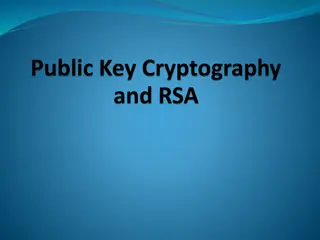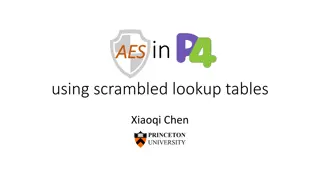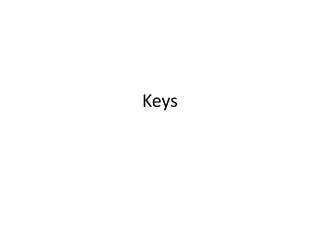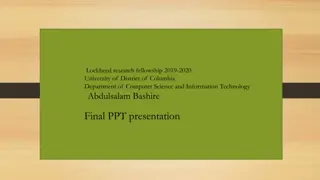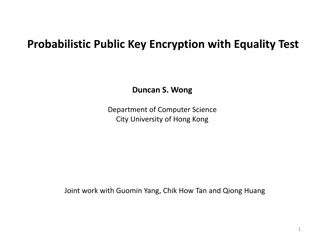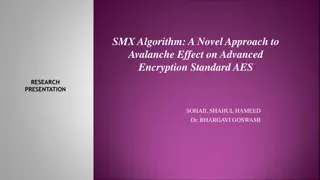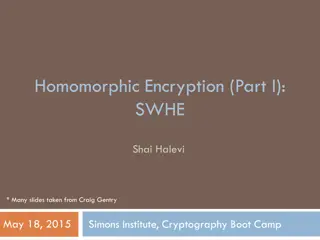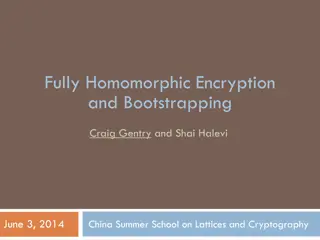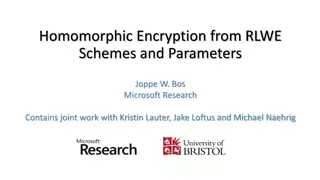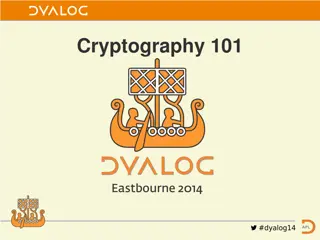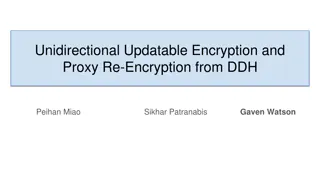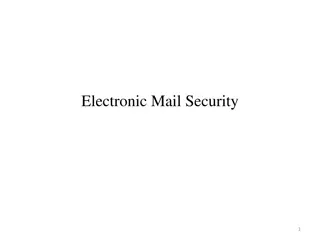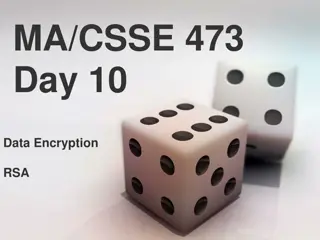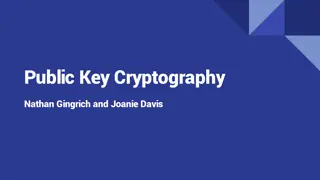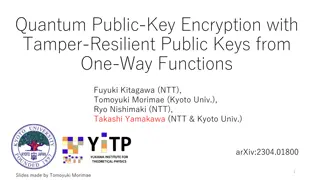Understanding Encryption: Keys, Algorithms, and Applications
Encryption plays a crucial role in securing data transmission and storage. It involves using keys and algorithms to convert plaintext information into a cipher that can only be deciphered with the correct key. This article explores different encryption methods, such as private and public key encryption, the importance of encryption in safeguarding sensitive information, and common applications of encryption in modern technology.
Download Presentation

Please find below an Image/Link to download the presentation.
The content on the website is provided AS IS for your information and personal use only. It may not be sold, licensed, or shared on other websites without obtaining consent from the author. Download presentation by click this link. If you encounter any issues during the download, it is possible that the publisher has removed the file from their server.
E N D
Presentation Transcript
ENCRYPTION David Kauchak CS52 Spring 2015
Admin Assignment 6 4 more assignments: Assignment 7, due 11/13 5pm Assignment 8, due 11/20 5pm Assignments 9 & 10, due 12/9 11:59pm
Admin Midterm next Thursday Covers everything from 9/24 10/27 + some minor SML Will not have to write any assembly 2 pages of notes Review sessions next week (TBA)
Encryption What is it and why do we need it?
Encryption I like bananas
Encryption I like bananas
Encryption: a bad attempt I like bananas
Encryption: the basic idea I like bananas I like bananas decrypt message encrypt message send encrypted message
Encryption: a better approach the hawk sleeps at midnight
Encryption uses Where have you seen encryption used?
Private key encryption I like bananas I like bananas decrypt message encrypt message send encrypted message
Private key encryption Any problems with this?
Public key encryption private key public key Two keys, one you make publicly available and one you keep to yourself
Public key encryption Share your public key with everyone
Public key encryption I like bananas I like bananas decrypt message encrypt message send encrypted message
Public key encryption I like bananas decrypt message Only the person with the private key can decrypt!
Modular arithmetic Normal arithmetic: a = b a is equal to b or a-b = 0 Modular arithmetic: a b (mod n) a-b = n*k for some integer k or a = b + n*k for some integer k or a % n = b % n (where % is the mod operator)
Modular arithmetic Which of these statements are true? 12 5 (mod 7) 52 92 (mod 10) 17 12 (mod 6) a-b = n*k for some integer k or a = b + n*k for some integer k or a % n = b % n (where % is the mod operator) 65 33 (mod 32)
Modular arithmetic Which of these statements are true? 12-5 = 7 = 1*7 12 % 7 = 5 = 5 % 7 12 5 (mod 7) 92-52 = 40 = 4*10 92 % 10 = 2 = 52 % 20 52 92 (mod 10) 17-12 = 5 17 % 6 = 5 12 % 6 = 0 17 12 (mod 6) 65-33 = 32 = 1*32 65 % 32 = 1 = 33 % 32 65 33 (mod 32)
Modular arithmetic properties If: a b (mod n) then: b mod n (mod n) a mod n mod /remainder operator congruence (mod n)
Modular arithmetic properties If: a b (mod n) then: b mod n (mod n) a mod n More importantly: (a+b) mod n (a mod n) + (b mod n) (mod n) and (a*b) mod n (a mod n) * (b mod n) (mod n) What do these say?
Modular arithmetic Why talk about modular arithmetic and congruence? How is it useful? Why might it be better than normal arithmetic? We can limit the size of the numbers we re dealing with to be at most n (if it gets larger than n at any point, we can always just take the result % n) The mod operator can be thought of as mapping a number in the range 0 number-1
GCD What does GCD stand for?
Greatest Common Divisor gcd(a, b) is the largest positive integer that divides both numbers without a remainder gcd(25, 15) = ?
Greatest Common Divisor gcd(a, b) is the largest positive integer that divides both numbers without a remainder gcd(25, 15) = 5 15 25 15 25 Divisors: 5 3 1 5 1
Greatest Common Divisor gcd(a, b) is the largest positive integer that divides both numbers without a remainder gcd(100, 52) = ?
Greatest Common Divisor gcd(a, b) is the largest positive integer that divides both numbers without a remainder gcd(100, 52) = 4 52 100 100 50 25 20 10 52 13 Divisors: 4 2 1 5 4 2 1
Greatest Common Divisor gcd(a, b) is the largest positive integer that divides both numbers without a remainder gcd(14, 63) = ? gcd(7, 56) = ? gcd(23, 5) = ? gcd(100, 9) = ? gcd(111, 17) = ?
Greatest Common Divisor gcd(a, b) is the largest positive integer that divides both numbers without a remainder gcd(14, 63) = 7 gcd(7, 56) = 7 gcd(23, 5) = 1 gcd(100, 9) = 1 gcd(111, 17) = 1 Any observations?
Greatest Common Divisor When the gcd = 1, the two numbers share no factors/divisors in common If gcd(a,b) = 1 then a is relatively prime to b This a weaker condition than primality, since any two prime numbers are also relatively prime, but not vice versa
Greatest Common Divisor A useful property: If two numbers are relatively prime (i.e. gcd(a,b) = 1), then there exists a c such that a*c mod b = 1
RSA public key encryption Have you heard of it? What does it stand for?
RSA public key encryption RSA is one of the most popular public key encryption algorithms in use RSA = Ron Rivest, Adi Shamir and Leonard Adleman
RSA public key encryption Choose a bit-length k Security increase with the value of k, though so does computation 1. Choose two primes p and q which can be represented with at most k bits 2. Let n = pq and (n) = (p-1)(q-1) () is called Euler s totient function 3. Find d such that 0 < d < n and gcd(d, (n)) = 1 4. Find e such that de mod (n) = 1 Remember, we know one exists! 5.
RSA public key encryption (n) = (p-1)(q-1) d: 0 < d < n and gcd(d, (n)) = 1 e: de mod (n) = 1 p: prime number q: prime number n = pq Given this setup, you can prove that given a number m: (me)d = med = m (mod n) What does this do for us, though?
RSA public key encryption (n) = (p-1)(q-1) d: 0 < d < n and gcd(d, (n)) = 1 e: de mod (n) = 1 p: prime number q: prime number n = pq private key public key (d, n) (e, n)
RSA encryption/decryption private key public key (d, n) (e, n) You have a number m that you want to send encrypted encrypt(m) = me mod n (uses the public key) How does this encrypt the message?
RSA encryption/decryption private key public key (d, n) (e, n) You have a number m that you want to send encrypted encrypt(m) = me mod n (uses the public key) - - - Maps m onto some number in the range 0 to n-1 If you vary e, it will map to a different number Therefore, unless you know d, it s hard to know original m was after the transformation
RSA encryption/decryption private key public key (d, n) (e, n) You have a number m that you want to send encrypted encrypt(m) = me mod n (uses the public key) decrypt(z) = zd mod n (uses the private key) Does this work?
RSA encryption/decryption encrypt(m) = me mod n decrypt(z) = zd mod n decrypt(z) = decrypt(me mod n) z is some encrypted message = (me mod n)d mod n definition of decrypt = (me)d mod n modular arithmetic = m mod n (me)d = med = m (mod n) Did we get the original message?
RSA encryption/decryption encrypt(m) = me mod n decrypt(z) = zd mod n decrypt(z) = decrypt(me mod n) z is some encrypted message = (me mod n)d mod n definition of decrypt = (me)d mod n modular arithmetic = m mod n (me)d = med = m (mod n) If 0 m < n, yes!
RSA encryption: an example (n) = (p-1)(q-1) d: 0 < d < n and gcd(d, (n)) = 1 e: de mod (n) = 1 p: prime number q: prime number n = pq p = 3 q = 13 n = ? (n) = ? d = ? e = ?
RSA encryption: an example (n) = (p-1)(q-1) d: 0 < d < n and gcd(d, (n)) = 1 e: de mod (n) = 1 p: prime number q: prime number n = pq p = 3 q = 13 n = ?
RSA encryption: an example (n) = (p-1)(q-1) d: 0 < d < n and gcd(d, (n)) = 1 e: de mod (n) = 1 p: prime number q: prime number n = pq p = 3 q = 13 n = 3*13 = 39
RSA encryption: an example (n) = (p-1)(q-1) d: 0 < d < n and gcd(d, (n)) = 1 e: de mod (n) = 1 p: prime number q: prime number n = pq p = 3 q = 13 n = 39 (n) = ?
RSA encryption: an example (n) = (p-1)(q-1) d: 0 < d < n and gcd(d, (n)) = 1 e: de mod (n) = 1 p: prime number q: prime number n = pq p = 3 q = 13 n = 39 (n) = 2*12 = 24
RSA encryption: an example (n) = (p-1)(q-1) d: 0 < d < n and gcd(d, (n)) = 1 e: de mod (n) = 1 p: prime number q: prime number n = pq p = 3 q = 13 n = 39 (n) = 24 d = ? e = ?

 undefined
undefined



